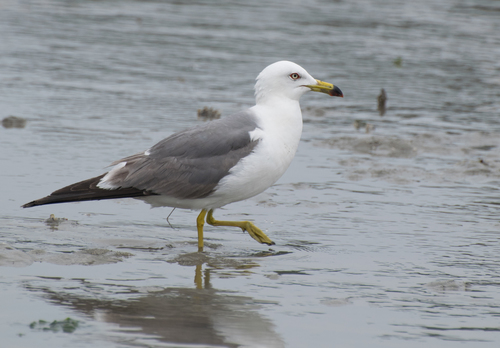
Black-tailed Gull
The Black-tailed Gull (*Larus crassirostris*) is a medium-sized gull species primarily found along the coasts of East Asia. It is easily recognizable by its distinctive black tail band, a feature unique among gulls of similar size. This species plays a vital role in its coastal ecosystem, acting as both predator and scavenger. Known for its adaptability, the Black-tailed Gull thrives in various coastal environments, including rocky shores, sandy beaches, and even urban harbors. It is sometimes referred to as the 'Umineko' in Japan, a name deeply embedded in Japanese folklore and literature, often symbolizing the sea and coastal life.
45-48 cm
Length
126-128 cm
Wingspan
Least Concern
Conservation Status
Distribution
The Black-tailed Gull is primarily found along the coasts of East Asia, including Japan, Korea, eastern China, and the Russian Far East. Some populations are resident year-round, while others undertake short-distance migrations, particularly during the winter months. They rarely venture far inland and are predominantly a coastal species.
Lifespan
The lifespan in the wild is not well documented, but it is estimated to be around 10-15 years, with some individuals potentially living longer.
Black-tailed Gull's Habitat
Habitat Types
Rocky coastlines, Sandy beaches, Estuaries, Harbors, Offshore islands
Climate Zones
Temperate, Subtropical
Adaptations
Black-tailed Gulls are well-adapted to coastal environments. They possess strong webbed feet for swimming and efficient flight capabilities for foraging over water. Their relatively robust bill allows them to handle a variety of prey items.
Variations
No recognized subspecies exist, although there may be minor variations in size or plumage across their range. These differences are generally not significant enough to warrant subspecific classification.
Appearance
Breeding Plumage
Adult breeding plumage features a white head, neck, and underparts, with a gray mantle and wings. The most distinctive feature is the broad black band on the tail. Non-breeding adults have some dark streaking on the head. Juveniles are mottled brown and gradually acquire adult plumage over 3-4 years.
Seasonal Feather Changes
The primary seasonal variation is the presence of dark streaking on the head of non-breeding adults, which is absent in breeding plumage.
Sex Based Plumage Differences
There is minimal sexual dimorphism in plumage. Males and females are visually very similar.
Notable Features
Distinctive black tail band, Yellow bill with a red and black spot near the tip, Dark eye, Yellow legs and feet
Diet and Feeding
Primary Foods
Small fish, Crustaceans, Mollusks, Insects, Marine invertebrates, Carrion, Garbage
Foraging Behavior
Black-tailed Gulls are opportunistic feeders. They forage by walking, wading, swimming, or flying. They often follow fishing boats and scavenge discarded fish and offal. They also plunge-dive for fish near the surface and steal food from other birds (kleptoparasitism).
Specializations
Their relatively strong bill allows them to handle a wide range of prey sizes and types.
Seasonal Diet Variations
Diet can vary seasonally depending on prey availability. During the breeding season, they may focus more on fish, while at other times they may rely more on scavenging.
Behavior
Social Structure
Black-tailed Gulls are highly social, often forming large breeding colonies and foraging flocks. Outside of the breeding season, they can be found in large groups at roosting sites.
Communication
Vocalizations, including a variety of calls for alarm, courtship, and territorial defense, Visual displays, such as head-bobbing and wing-lifting
Migration
Some populations are resident, while others undertake short-distance migrations. Migratory movements are influenced by food availability and weather conditions.
Territorial or Group Behaviors
During the breeding season, pairs defend small territories around their nests. They are aggressive towards intruders, including other gulls and potential predators.
Conservation
Threats
Habitat loss due to coastal development, Pollution, including plastic ingestion and oil spills, Disturbance at breeding colonies, Climate change, affecting prey availability
Protection Programs
Some breeding colonies are protected within national parks and wildlife reserves
Local National Laws
Protected under various national wildlife protection laws in countries within its range.
Population Trend
Stable
Population Estimates
The global population is estimated to be around 1.2 million birds.
Interesting Facts
They are known for their loud, cat-like calls.
This vocalization is the origin of their Japanese name, 'Umineko,' which translates to 'sea cat'.
Black-tailed Gulls often follow fishing boats.
This behavior allows them to scavenge discarded fish and offal, providing an easy food source.
Black-tailed Gulls have been featured in Japanese literature and art for centuries.
They hold a special place in Japanese culture, representing the sea and coastal life.
Faqs about Black-tailed Gull
What is the easiest way to identify a Black-tailed Gull?
The most distinctive feature is the broad black band on the tail, which is unique among gulls of similar size.
Are Black-tailed Gulls aggressive?
They can be aggressive during the breeding season when defending their nests and young. Otherwise, they are generally not aggressive towards humans unless provoked.
Where can I see Black-tailed Gulls?
They are commonly found along the coasts of East Asia, including Japan, Korea, eastern China, and the Russian Far East. Look for them near harbors, beaches, and rocky coastlines.
Copyright @ Nature Style Limited. All Rights Reserved.
 English
English